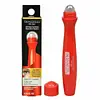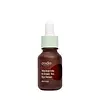What's inside
What's inside
 Key Ingredients
Key Ingredients

 Benefits
Benefits

 Concerns
Concerns

 Ingredients Side-by-side
Ingredients Side-by-side

Water
Skin ConditioningGlycerin
HumectantNiacinamide
SmoothingGlucose
HumectantCamellia Sinensis Leaf Extract
AntimicrobialAscorbyl Glucoside
AntioxidantPalmitoyl Oligopeptide
CleansingPalmitoyl Tetrapeptide-7
Skin ConditioningAcetyl Glucosamine
Skin ConditioningPanthenol
Skin ConditioningSaccharomyces/Xylinum/Black Tea Ferment
Skin ConditioningXanthan Gum
EmulsifyingYeast Extract
Skin ConditioningDipotassium Glycyrrhizate
HumectantLithothamnion Calcareum Powder
AbrasiveMica
Cosmetic ColorantThioctic Acid
AntioxidantRetinyl Palmitate
Skin ConditioningAscorbic Acid
AntioxidantTocopheryl Acetate
AntioxidantBeta-Carotene
Skin ConditioningHydroxyethylcellulose
Emulsion StabilisingPEG-14m
Emulsion StabilisingCarbomer
Emulsion StabilisingPolysorbate 20
EmulsifyingSodium Borate
BufferingButylene Glycol
HumectantTitanium Dioxide
Cosmetic ColorantDisodium EDTA
Phenoxyethanol
PreservativeMethylisothiazolinone
PreservativeWater, Glycerin, Niacinamide, Glucose, Camellia Sinensis Leaf Extract, Ascorbyl Glucoside, Palmitoyl Oligopeptide, Palmitoyl Tetrapeptide-7, Acetyl Glucosamine, Panthenol, Saccharomyces/Xylinum/Black Tea Ferment, Xanthan Gum, Yeast Extract, Dipotassium Glycyrrhizate, Lithothamnion Calcareum Powder, Mica, Thioctic Acid, Retinyl Palmitate, Ascorbic Acid, Tocopheryl Acetate, Beta-Carotene, Hydroxyethylcellulose, PEG-14m, Carbomer, Polysorbate 20, Sodium Borate, Butylene Glycol, Titanium Dioxide, Disodium EDTA, Phenoxyethanol, Methylisothiazolinone
Camellia Sinensis Leaf Water
MaskingGlycerin
HumectantButylene Glycol
HumectantNiacinamide
SmoothingWater
Skin ConditioningMethylpropanediol
SolventDiglycerin
Humectant1,2-Hexanediol
Skin ConditioningEthoxydiglycol
HumectantSodium Hyaluronate
HumectantPanthenol
Skin ConditioningGlycyrrhiza Glabra Root Extract
BleachingCaffeine
Skin ConditioningTocopherol
AntioxidantAdenosine
Skin ConditioningAscorbic Acid
AntioxidantRetinol
Skin ConditioningDipeptide Diaminobutyroyl Benzylamide Diacetate
Skin ConditioningHippophae Rhamnoides Oil
EmollientLycium Chinense Fruit Extract
AntioxidantCalendula Officinalis Flower Extract
MaskingGlycine Soja Oil
EmollientChlorella Vulgaris Extract
Skin ConditioningMelia Azadirachta Flower Extract
Skin ConditioningMelia Azadirachta Leaf Extract
Skin ConditioningCurcuma Longa Root Extract
MaskingLawsonia Inermis Flower/Fruit/Leaf Extract
MaskingOcimum Basilicum Flower/Leaf Extract
TonicOcimum Sanctum Leaf Extract
Skin ConditioningCorallina Officinalis Extract
Skin ConditioningGlucose
HumectantFructose
HumectantFructooligosaccharides
HumectantPentylene Glycol
Skin ConditioningHydrogenated Lecithin
EmulsifyingSodium Phytate
Octanediol
Polyglyceryl-10 Oleate
Skin ConditioningCarbomer
Emulsion StabilisingEthylhexylglycerin
Skin ConditioningTromethamine
BufferingC12-14 Pareth-12
EmulsifyingCamellia Sinensis Leaf Water, Glycerin, Butylene Glycol, Niacinamide, Water, Methylpropanediol, Diglycerin, 1,2-Hexanediol, Ethoxydiglycol, Sodium Hyaluronate, Panthenol, Glycyrrhiza Glabra Root Extract, Caffeine, Tocopherol, Adenosine, Ascorbic Acid, Retinol, Dipeptide Diaminobutyroyl Benzylamide Diacetate, Hippophae Rhamnoides Oil, Lycium Chinense Fruit Extract, Calendula Officinalis Flower Extract, Glycine Soja Oil, Chlorella Vulgaris Extract, Melia Azadirachta Flower Extract, Melia Azadirachta Leaf Extract, Curcuma Longa Root Extract, Lawsonia Inermis Flower/Fruit/Leaf Extract, Ocimum Basilicum Flower/Leaf Extract, Ocimum Sanctum Leaf Extract, Corallina Officinalis Extract, Glucose, Fructose, Fructooligosaccharides, Pentylene Glycol, Hydrogenated Lecithin, Sodium Phytate, Octanediol, Polyglyceryl-10 Oleate, Carbomer, Ethylhexylglycerin, Tromethamine, C12-14 Pareth-12
Ingredients Explained
These ingredients are found in both products.
Ingredients higher up in an ingredient list are typically present in a larger amount.
Ascorbic Acid is is pure Vitamin C. This form makes up the largest amount of vitamin C found naturally in our skin.
Not only is vitamin C great for your overall health and immune system, it also has plenty of benefits on your skin.
Vitamin C is best used for brightening skin. It improves dark spots, acne scars, and hyperpigmentation. This is because it blocks the process of skin darkening when exposed to UV.
Remember: Vitamin C should not replace sunscreen!
Your skin uses vitamin C to build collagen. Collagen is one key component in having a strong skin barrier and plump skin. Vitamin C also plays a role in regulating collagen, thus making it effective in improving wrinkles and fine lines.
Ascorbic acid shows potent antioxidant activity. As an antioxidant, it helps fight free-radicals. Free-radicals are molecules that may damage your skin cells. These antioxidants also protect skin against UV damage.
The best formulations include Vitamin E and/or ferulic acid. These two ingredients help stabilize and provide a boost in the benefits of ascorbic acid. This is because ascorbic acid becomes unstable when exposed to UV and air. In fact, you can tell your ascorbic acid has oxidized when it turns an orange-yellow color.
Ascorbic acid is generally compatible with other ingredients. However, using ascorbic acid with other active ingredients might cause irritation. Two ingredients: copper ions and benzoyl peroxide, will inactivate ascorbic acid completely.
Read more about other types of Vitamin C:
Foods rich with vitamin C include oranges, strawberries, broccoli, bell peppers, and more. When consuming Vitamin C, your skin receives a portion of the nutrients.
Learn more about Ascorbic AcidButylene Glycol (or BG) is used within cosmetic products for a few different reasons:
Overall, Butylene Glycol is a safe and well-rounded ingredient that works well with other ingredients.
Though this ingredient works well with most skin types, some people with sensitive skin may experience a reaction such as allergic rashes, closed comedones, or itchiness.
Learn more about Butylene GlycolCarbomer is a polymer of acrylic acid. Its main role is to create a gel consistency.
A high amount of carbomer can cause pilling or balling up of products. Don't worry, most products contain 1% or less of carbomer.
Glucose is a simple sugar and is the most important source of energy in all organisms.
In skincare, glucose is used to hydrate the skin. It also acts as a prebiotic for our natural biome.
Glucose is hydrating due to its humectant property. As a humectant, glucose draws moisture from the air and from deeper levels in the skin.
Our skin contains many sugars that act as prebiotics and help strengthen our natural microbiome. Having a healthy microbiome helps protect our skin from harmful bacteria and other contaminants.
Studies show glucose may help with fading discoloration and pigmentation. This is because our skin metabolizes glucose into lactic acid. Lactic acid is an AHA that helps exfoliate the top layer of skin.
Learn more about GlucoseGlycerin is already naturally found in your skin. It helps moisturize and protect your skin.
A study from 2016 found glycerin to be more effective as a humectant than AHAs and hyaluronic acid.
As a humectant, it helps the skin stay hydrated by pulling moisture to your skin. The low molecular weight of glycerin allows it to pull moisture into the deeper layers of your skin.
Hydrated skin improves your skin barrier; Your skin barrier helps protect against irritants and bacteria.
Glycerin has also been found to have antimicrobial and antiviral properties. Due to these properties, glycerin is often used in wound and burn treatments.
In cosmetics, glycerin is usually derived from plants such as soybean or palm. However, it can also be sourced from animals, such as tallow or animal fat.
This ingredient is organic, colorless, odorless, and non-toxic.
Glycerin is the name for this ingredient in American English. British English uses Glycerol/Glycerine.
Learn more about GlycerinNiacinamide is a multitasking form of vitamin B3 that strengthens the skin barrier, reduces pores and dark spots, regulates oil, and improves signs of aging.
And the best part? It's gentle and well-tolerated by most skin types, including sensitive and reactive skin.
You might have heard of "niacin flush", or the reddening of skin that causes itchiness. Niacinamide has not been found to cause this.
In very rare cases, some individuals may not be able to tolerate niacinamide at all or experience an allergic reaction to it.
If you are experiencing flaking, irritation, and dryness with this ingredient, be sure to double check all your products as this ingredient can be found in all categories of skincare.
When incorporating niacinamide into your routine, look out for concentration amounts. Typically, 5% niacinamide provides benefits such as fading dark spots. However, if you have sensitive skin, it is better to begin with a smaller concentration.
When you apply niacinamide to your skin, your body converts it into nicotinamide adenine dinucleotide (NAD). NAD is an essential coenzyme that is already found in your cells as "fuel" and powers countless biological processes.
In your skin, NAD helps repair cell damage, produce new healthy cells, support collagen production, strengthen the skin barrier, and fight environmental stressors (like UV and pollution).
Our natural NAD levels start to decline with age, leading to slower skin repair, visible aging, and a weaker skin barrier. By providing your skin niacinamide, you're recharging your skin's NAD levels. This leads to stronger, healthier, and younger looking skin.
Another name for vitamin B3 is nicotinamide. This vitamin is water-soluble and our bodies don't store it. We obtain Vitamin B3 from either food or skincare. Meat, fish, wheat, yeast, and leafy greens contain vitamin B3.
The type of niacinamide used in skincare is synthetically created.
Learn more about NiacinamidePanthenol is a common ingredient that helps hydrate and soothe the skin. It is found naturally in our skin and hair.
There are two forms of panthenol: D and L.
D-panthenol is also known as dexpanthenol. Most cosmetics use dexpanthenol or a mixture of D and L-panthenol.
Panthenol is famous due to its ability to go deeper into the skin's layers. Using this ingredient has numerous pros (and no cons):
Like hyaluronic acid, panthenol is a humectant. Humectants are able to bind and hold large amounts of water to keep skin hydrated.
This ingredient works well for wound healing. It works by increasing tissue in the wound and helps close open wounds.
Once oxidized, panthenol converts to pantothenic acid. Panthothenic acid is found in all living cells.
This ingredient is also referred to as pro-vitamin B5.
Learn more about PanthenolWater. It's the most common cosmetic ingredient of all. You'll usually see it at the top of ingredient lists, meaning that it makes up the largest part of the product.
So why is it so popular? Water most often acts as a solvent - this means that it helps dissolve other ingredients into the formulation.
You'll also recognize water as that liquid we all need to stay alive. If you see this, drink a glass of water. Stay hydrated!
Learn more about Water